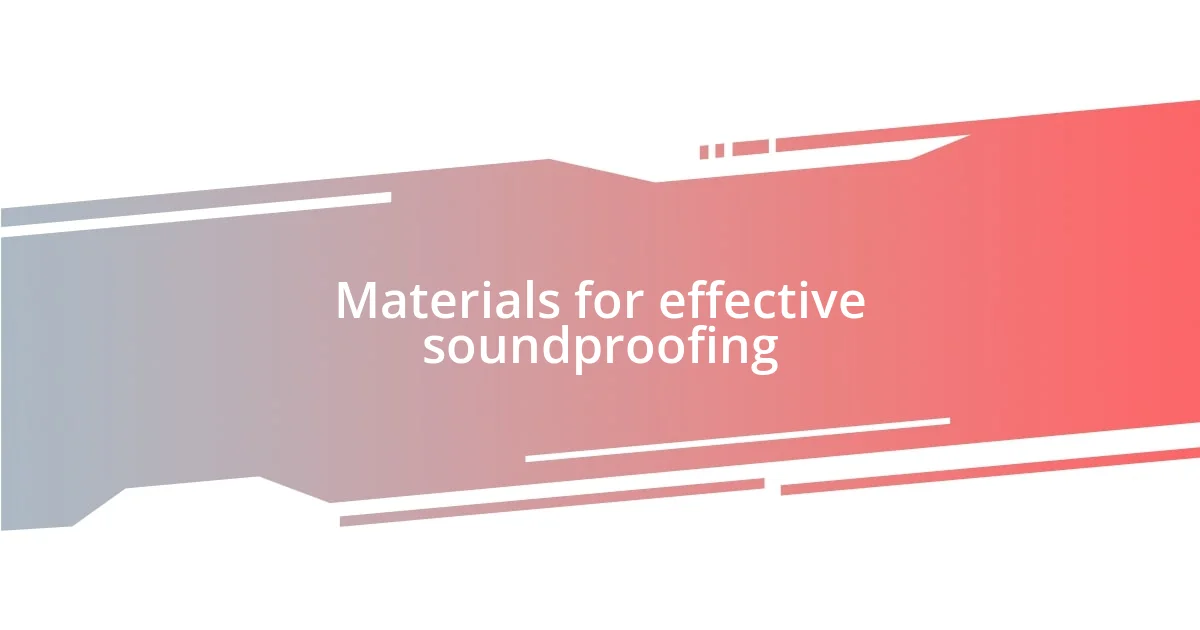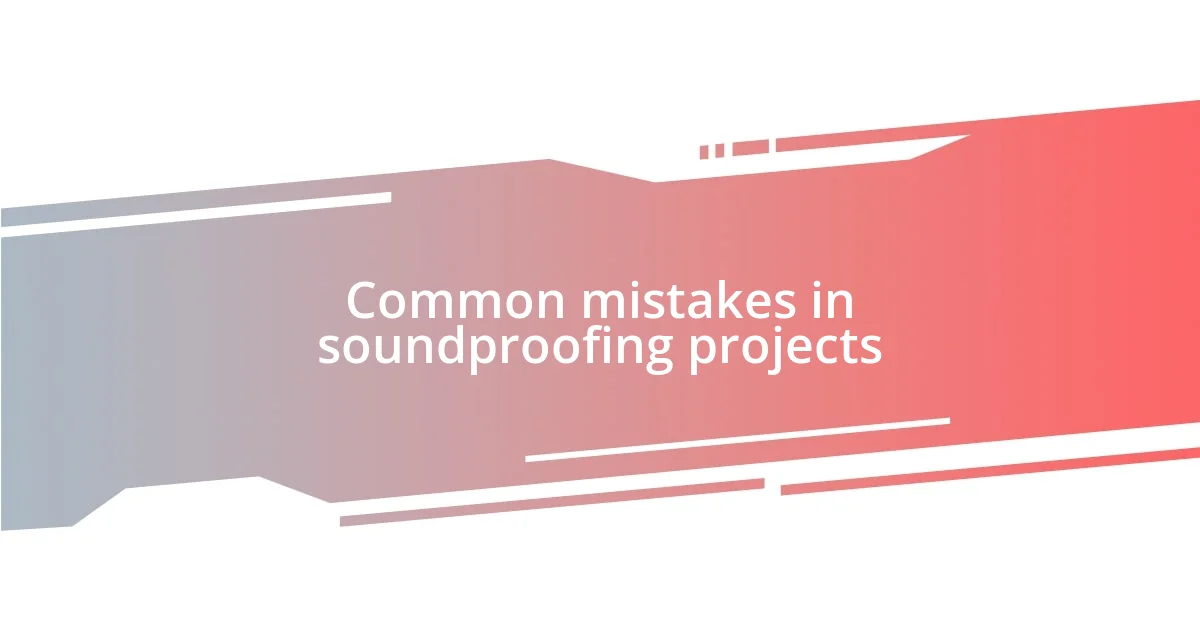Key takeaways:
- Understand the difference between sound absorption (e.g., carpets, acoustic panels) and sound blocking (e.g., thick walls, Mass Loaded Vinyl) for effective soundproofing.
- Regularly assess and maintain soundproofing measures, like sealing gaps and keeping materials clean, to ensure continued effectiveness.
- Avoid common mistakes such as improper installation and ignoring adjacent spaces, which can significantly undermine soundproofing efforts.

Understanding soundproofing basics
When I first dove into soundproofing, I was surprised by how much there was to learn beyond just slapping up some material. Sound travels in waves, and these waves can penetrate through walls, floors, and ceilings, making it crucial to understand how to effectively block or absorb them. Have you ever felt overwhelmed by the constant noise of a city or rowdy neighbors? I certainly have, and it taught me that the right materials and techniques can make a world of difference.
One key aspect to grasp is the difference between sound absorption and sound blocking. Absorption refers to materials that soak up sound waves, like carpets and acoustic panels, while blocking involves creating barriers that prevent sound from passing through, like thick walls or specialized soundproofing products. I once tried layering drywall for sound blocking, and it was a game-changer—now I can finally enjoy a movie without raising the volume to drown out outside noise!
Often, people overlook the importance of sealing gaps and cracks in their spaces, thinking that larger solutions are the only answer. However, I discovered that something as simple as caulk can drastically reduce sound leaks. When I sealed the tiny gaps around my windows, it felt like pulling a thick blanket over the entire room; the difference was astounding. Isn’t it fascinating how paying attention to the little things can lead to such significant improvements?

Identifying soundproofing needs
When identifying your soundproofing needs, I believe the first step is to assess the specific sources of noise that affect your environment. Whether it’s a loud street, a bustling office, or even the sounds of a baby crying next door, recognizing these factors can significantly guide your choices. I remember living in an apartment where the neighbors loved to host late-night parties, and pinpointing that disruptive bass made me realize I needed more than just a few panels; I needed a strategic approach to soundproofing.
To help you determine your soundproofing requirements, consider these key points:
- Source of Noise: Identify whether the noise is internal (from other rooms) or external (from outside).
- Frequency of Noise: Assess if the noise is a constant hum or intermittent, as different types of sounds may require different solutions.
- Room Usage: Think about how sound quality affects your daily activities; is it for work, relaxation, or entertainment?
- Budget Constraints: Consider how much you’re willing to invest, as some methods can be costly, while others are more budget-friendly.
- Material Limitations: Evaluate the existing construction of your space and what materials can be successfully added.
By understanding these factors, you can create a more tailored and effective soundproofing plan.

Assessing your space for soundproofing
Assessing your space for soundproofing can seem daunting, but I’ve learned that it’s about observing and understanding the characteristics of your environment. For instance, when I first moved into my condo, I walked around the space, listening closely to how sound behaved. I discovered that the thin walls made it easy to hear my neighbor’s television one floor above me. That realization prompted a deeper assessment of which areas needed the most attention.
As I began to look at the room layout, I took note of large windows and doorways that could potentially allow noise to seep in. I remember taking a moment to sit quietly by my living room window, hearing the busy street outside and reflecting on how much of that noise reached me inside. It truly reinforced the importance of focusing on those weak points in the architecture when considering soundproofing solutions.
To guide your assessment, I’ve created a simple comparison table to help visualize various factors. This table encapsulates the difference between the features of common materials used for soundproofing, assisting you in making informed choices for your own space.
| Material Type | Function |
|---|---|
| Acoustic Panels | Sound absorption |
| Mass Loaded Vinyl | Sound blocking |
| Weather Stripping | Sealing gaps |
| Thick Curtains | Sound absorption |
| Double Glazed Windows | Sound blocking |

Materials for effective soundproofing
When it comes to materials for effective soundproofing, I can’t stress enough how crucial it is to pick the right ones for your specific needs. For example, I once experimented with acoustic panels in my studio, hoping to eliminate echoes while recording. It was fascinating to see how much of a difference they made in reducing the reverberation, making my recordings sound crisp and professional.
Mass Loaded Vinyl (MLV) is another fantastic option I discovered during my soundproofing journey. I remember placing MLV behind my drywall during a renovation project, and the improvement was immediate. It effectively blocked sounds from the noisy street outside, giving me the quiet retreat I craved. That experience taught me that sound blocking materials really are game-changers, especially in urban settings.
Don’t underestimate the power of simple yet effective solutions like thick curtains; they can magically absorb sound and add a cozy vibe to your space. When I hung up a pair of heavy drapes in my living room, I was genuinely surprised at how much background noise, like traffic and chatter, faded away. Have you ever felt that sense of peace when the chaos outside dims? It’s a small investment that can yield tremendous benefits for your comfort at home.

Installation techniques for soundproofing
When it comes to installation techniques for soundproofing, I’ve learned that proper sealing is key. For instance, during a DIY project in my bedroom, I was surprised at how much sound came through the cracks around the door frame. By applying weather stripping, I not only achieved a snug fit but also felt an immediate reduction in external noise—almost like my room transformed into a peaceful oasis.
Another technique that can yield impressive results is adding mass to your walls. I once decided to double-layer drywall in my home office, and not only did it block intrusive sounds, but it also improved my focus during work hours. Have you ever noticed how important a quiet space is for productivity? The difference was remarkable; I could finally hear myself think!
Don’t overlook the ceiling when soundproofing your space. I remember installing acoustic tiles in my basement to absorb sounds from the upstairs. The moment those tiles were up, my basement became an inviting place for movie nights. It was fascinating to realize that a few simple adjustments could create such a dramatic shift in atmosphere—sometimes, all it takes is being a bit innovative with the installation process!

Maintenance tips for soundproofed spaces
Maintaining a soundproofed space might seem straightforward, but regular checks can make a significant difference. I remember one time when I thought my soundproofing was still effective, only to find that a tiny gap I hadn’t even noticed was letting in unwanted noise. Making it a habit to inspect seals around windows and doors every few months can save you from rediscovering those disruptive sounds.
Another crucial tip is to keep your soundproofing materials clean and in good repair. I once neglected my acoustic panels, allowing dust to build up, which not only diminished their effectiveness but also affected the air quality in my studio. A simple routine of dusting or replacing damaged materials can rejuvenate your sound barrier and keep your space feeling fresh and vibrant. Have you ever felt like your environment impacts your mood? A clean space can definitely lift your spirits.
Lastly, pay attention to how your space evolves over time. I learned this when I redecorated my living room and realized that my new furniture arrangement inadvertently affected sound flow. It’s essential to reassess your layout and how sound travels after any major changes; sometimes, a slight adjustment can significantly enhance your soundproofing effectiveness. Have you ever noticed how sound behaves differently in various setups? It’s always worth taking a moment to ensure that your soundproofing remains up to par.

Common mistakes in soundproofing projects
One common mistake in soundproofing projects is focusing solely on materials without considering the installation process. I recall talking to a friend who invested in high-end acoustic panels but didn’t secure them properly to the walls. When we tested the space after installation, the difference was underwhelming. Have you ever felt frustrated when expecting results that just didn’t come? The lesson here is that even the best materials won’t perform effectively if they aren’t installed correctly.
Another pitfall is overlooking the importance of soundproofing adjacent spaces. I faced this when I soundproofed my music room, only to hear the echo of my partner’s voice from the adjacent room during practice sessions. It’s not enough to focus on one room—paying attention to shared walls and floors can make all the difference in overall noise reduction. This often leads me to wonder: how many people assume sound only travels in one direction?
Lastly, many underestimate the impact of decor and furniture placement on soundproofing effectiveness. I once filled my living room with a lot of minimalistic furniture, thinking it would create a spacious feel. Instead, I ended up amplifying the sound, making conversations difficult. It’s intriguing to consider how each element in a space influences sound; have you thought about rearranging to enhance acoustics in your own home? Experimenting with different arrangements and materials can lead to unexpected improvements.













